
My first ever hog was a decent sized boar of about 150-200 pounds, taken on the run at 25 yards or so with a 22LR rimfire, while I was out looking for squirrels. I was 15 years old, and they were not common in the area just north of San Antonio, yet. I have been hunting them ever since, whenever I could get the time. That pig was either very unlucky or my prowess with a long gun was extraordinary. He was running with a small sounder of 5-10 others when I swung the sights on him as he ran past me. I never even considered the fact that all I had was a 22, just that he was there and by golly, I was going to shoot him. At the shot, he folded up, hit the ground and slid 3 or 4 feet. I stood there amazed because that shouldn’t have happened! I later discovered I had brained him, quite by luck as I really can’t say where I was holding as I was swinging the gun through him.
That story is shared just to illustrate that if you intend on braining your quarry, then it really doesn’t matter what you use as long as it can get 3-6″ of penetration. Plenty of people have taken hogs with air guns, by simply braining them and I’m not talking about the new large caliber air guns, but the good old .177, .20, .22 caliber stuff that has been around for years.
If you brain your hog then a blood trail isn’t necessary as the animal should be right where they were when you shot them. This makes for a very easy trailing job, a slightly less messy field dressing job, and no meat loss due to bullet damage. However, it also means you NEED to be very precise, regardless of the caliber and bullet type you use. You’re trying to hit a 3″ target that doesn’t stop moving very often and you need to hit it from the proper angle or even a good bullet can skip off the skull. This shot is not one I recommend, I have only done it once intentionally and was using a 22 rimfire with the distance less than 25 yards. It was at night and the pig was unaware of my presence and walking slowly across me from left to right. He was a good-sized pig of about 150 pounds. His picture and the gun used are below.
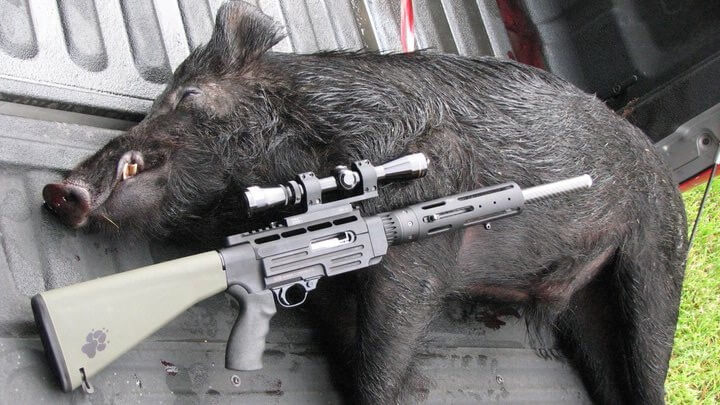
My preferred shot (no matter what weapon I have in my hands; bow, handgun, shotgun, or rifle) is through the chest cavity taking out lungs, heart, possibly severing the spine, breaking a leg or two, and leaving TWO holes, one in and one out. Invariably the exit hole will be larger and that is where most of the blood will exit the body. The smaller entrance hole will leak some but not nearly as much as an exit hole will. Now before we go further into this, I am making statements based on what I have done and what I have seen done by other hunters, nothing hypothetical, it is all firsthand knowledge. Most hunters will simply go to the local gun shop or sporting goods store and buy standard ammo with standard cup and core type bullets, not premium bullets. For this reason, I have found it vitally important to use enough bullet. I tell my guests to bring something that uses at least 120grs. of bullet.
This eliminates pretty much everything below .25 cal. Yes, I know .24 cal and .22 cal guns have killed tons of hogs, and they will continue to do so. I have used .223 caliber guns to take hogs, quite a number of hogs. I have a good friend that shot a very nice boar with a 77gr. bullet out of an AR, at about 50 yards. He placed the bullet very well and it took us 45 minutes to an hour just to find the first drop of blood so we could start to trail it up. We took up the trail and jumped the boar 3 more times, each time we were able to get more bullets into it from a 308 and a 45 colt. The third time we jumped him I was able to get a hard cast 335gr. bullet from my 45 colt into his pelvic girdle and stop his progress. We guessed him at about 280 pounds. He was a beautiful looking grizzled long-haired boar. Other than the original 77gr. bullet that started the job, he had taken three 150gr. bullets from the 308, and two 335gr. bullets from my 45 colt. The hit from the 223 bullet was a great broadside lung hit, but it only made it to one lung, from 50 yards. It took us 3+ hours from first shot to last shot and required me to be on my hands and knees for over an hour in order to track him through the thick brush.
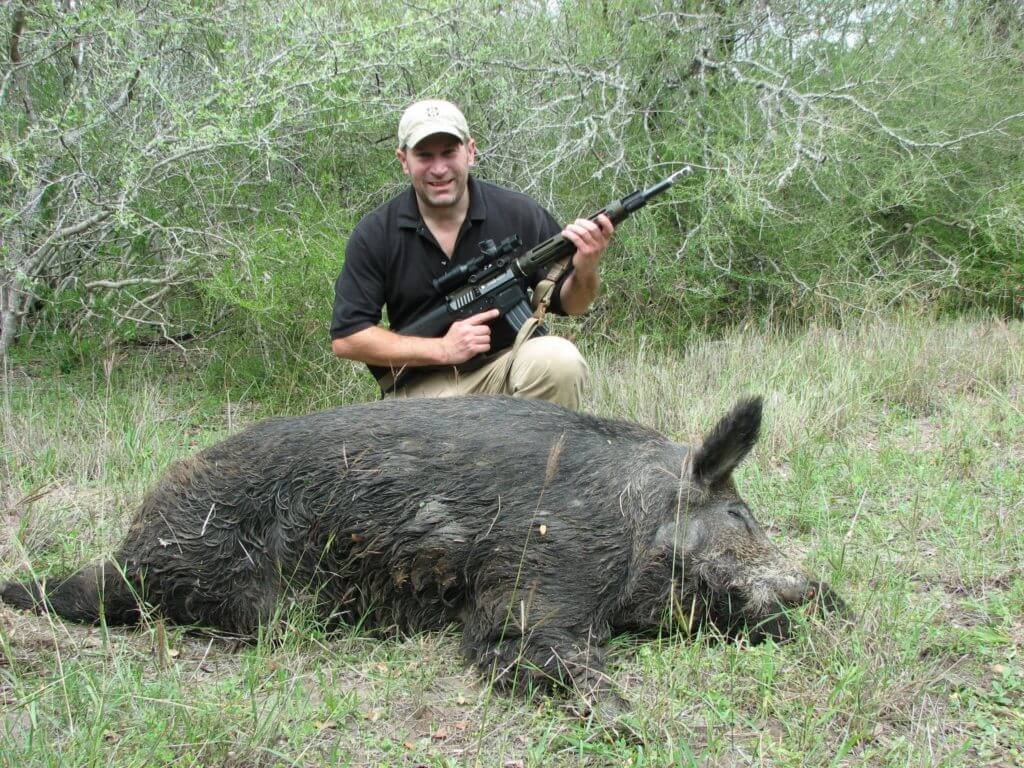
The way I see it, the 223 rem / 5.56×45 was made for targets that weigh 75-125 pounds maximum, and that’s a good weight range for it. If you take nothing but broadside shots, it will do the job. Most of the pigs you come across are going to be in that weight range, but what happens when 180 or 250-pound pigs show up? I’ve had enough 30cal. 150gr. bullets from 308 win. or larger calibers fail to get adequate penetration on broadside hits that I have personally stopped using and recommending them for pigs unless a premium bullet is used.
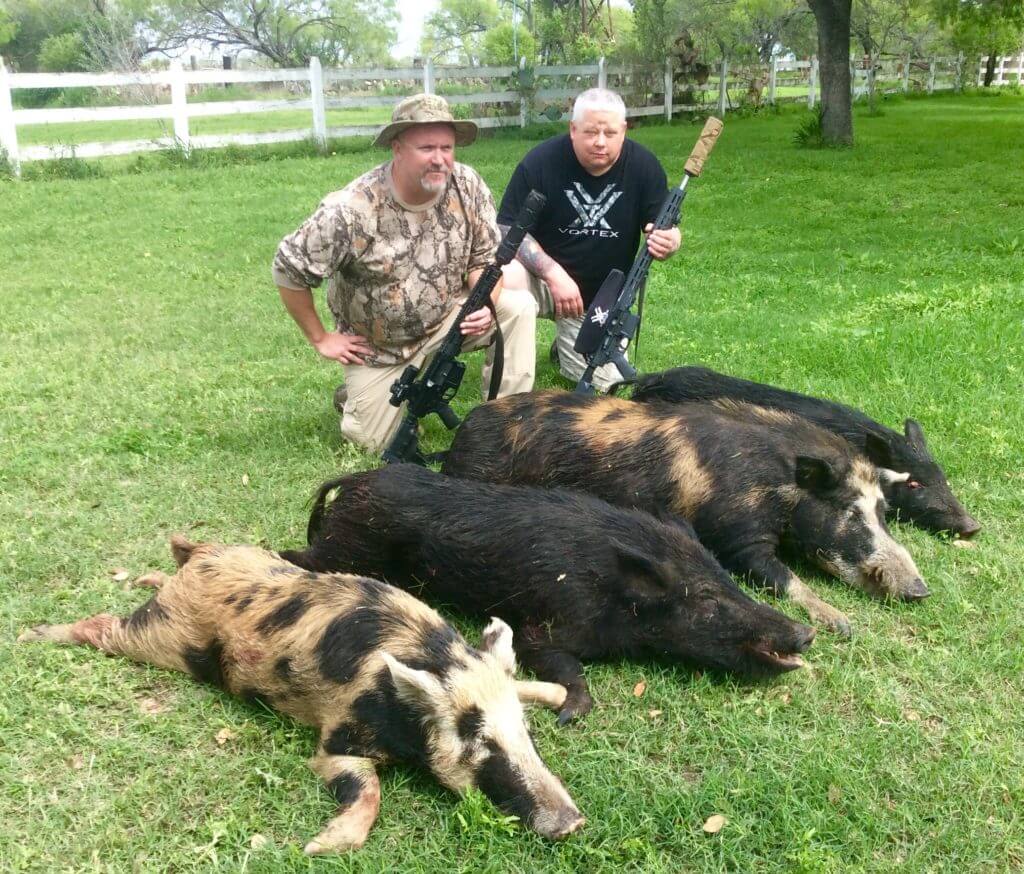
As I said earlier, I want an exit hole. I want to break big heavy bones so that means bigger heavier bullets, or at least tougher bullets. Simply using heavy bullets, however, is not the answer A heavy bullet may have worse performance on a pig than a fragile light bullet will. You need to match your velocity to the bullet you’re using. Moderate velocity is easier on a bullet than hypervelocity, it allows the bullet to penetrate and expand at a reasonable rate. A 30cal. bullet of 125-130 grains meant for velocities in the 3000+ fps range will do an admirable job when pushed at only 2200-2400 fps.

By the same token, a 300gr. bullet meant for 1300-1500fps can provide less stellar performance when pushed at 2000+fps. These are examples that I have had personally and learned from. The calibers used were 300 Blackout and 45/70, the little 30cal. 125gr. Sierra soft point performs great at 300BO velocities. Now the 45/70, no one should argue that it isn’t a great round for medium or large game. Take a bullet meant for original 45/70 velocities and push it almost 1000fps faster and it can give less than desirable penetration.

Run a bullet thru an animal without hitting bone and you’ll probably have very acceptable performance from most any expanding type bullets. But hit a heavy leg bone, multiple ribs, or need to drive a bullet forward thru the pelvic girdle and you’ll benefit more from extra mass than extra velocity. Now, remember we’re still referring to normal standard construction jacketed bullets. If you decide to use premium bullets, like a Partition type or a mono metal type, then you can get away with using lighter projectiles and more velocity. The same goes for a good cast bullet of proper design.
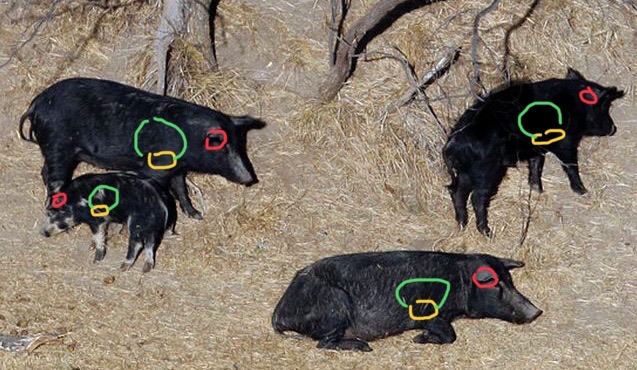
If you’re thinking that I am advocating penetration over expansion, you’d be right. A little expansion is good, just not too much so that it decreases or hinders penetration. Two holes leak more than one, a bigger hole leaks more than a smaller one. When it comes to pigs, they are tougher than deer, heavier boned, thicker skinned, and built just a little different. A 150-pound pig is a small to medium-sized one, yet in many places, a 150-pound deer is medium to large-sized. If you go with moderate velocity for caliber, and a mid to heavyweight bullet, you shouldn’t have any issues no matter what size pig shows up, provided you put the bullet where it needs to go.
In many areas, pigs have become mostly nocturnal due to pressure being put on them by hunters. This means when you are able to poke a hole in one, your light will be low or nonexistent. It also means you would gain a lot by having a good blood trail to follow rather than on hands and knees searching for small drops or splotches with a flashlight. All of the pigs that I’ve tracked and lost were due to poor or marginal hits, and small to no blood trails. Some were hit with good bullets that simply didn’t exit, but we luckily found them by looking in the general direction of travel and them expiring.
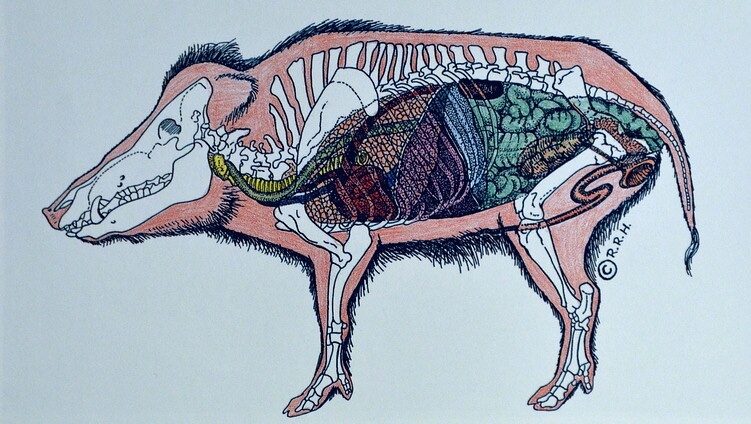
Much has been written about how dangerous or super animal tough feral pigs are. Compared to deer, they are tougher. They do not require larger than normal calibers to kill them, just proper calibers with proper bullets. Any of the normally considered “deer” calibers will perform adequately with proper bullets placed in proper places. I also mentioned that they are built differently. If you look at the anatomy of a feral hog you’ll notice that the spine drops sharply in order to connect to the back of the head. This places the neck portion of the spine much lower than many people realize. That area in front of the front legs right in the middle of the “neck” is where the spine is. This is another spot I will aim for. Especially if I’m using a light bullet or minimally effective caliber, sever the spine here and the pig will drop right where it was standing. Here is a 180-pound pig taken with a 90gr. mono metal bullet that severed the spine in front of the shoulder. Knowing I had a lighter than preferred bullet I placed the bullet where it would do the most good, and the pig never took another step.
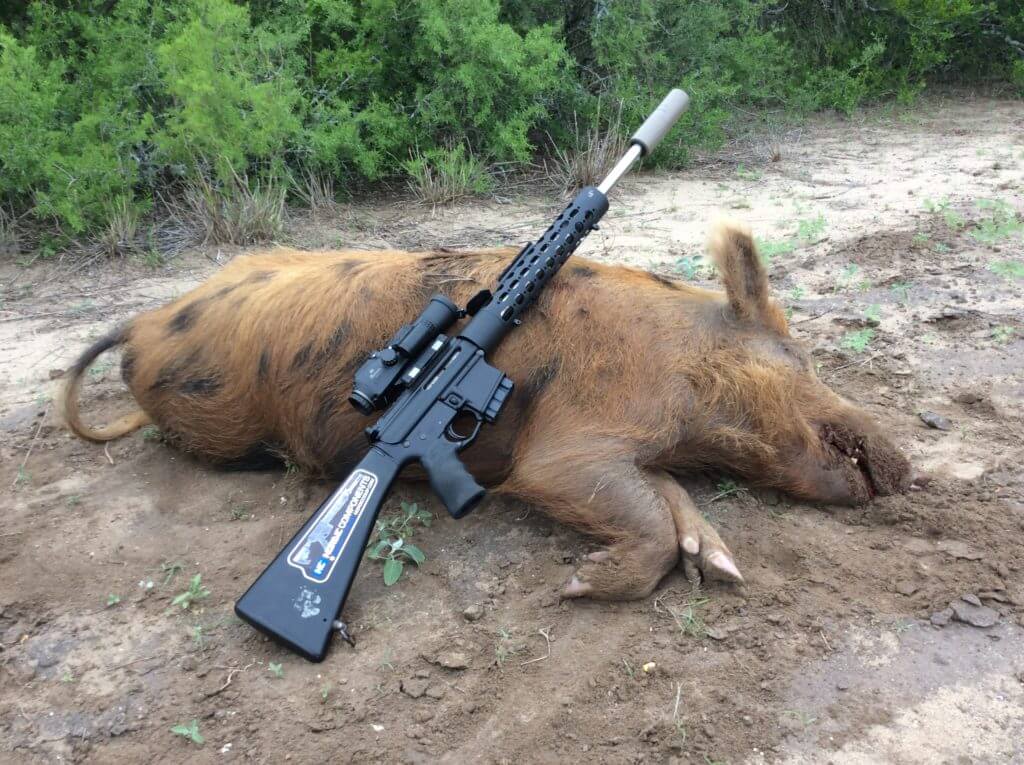
Earlier I mentioned that I recommend for my guests to use at least 120gr. of bullet. Using that as a standard it means a .25 cal or 6.5 cal. rifle is your minimum. Any other common caliber of larger size moves you from adequate to optimal. My favorite and often recommended general-purpose hunting rifle calibers are 6.5×55 and 308 win. or anything in that class of round. Those rounds will do very well from 10 yards to 300 yards, provided you use the right bullets and hit the animal well. They are adequate for larger pigs but can still not provide an exit wound if the animal is a boar.
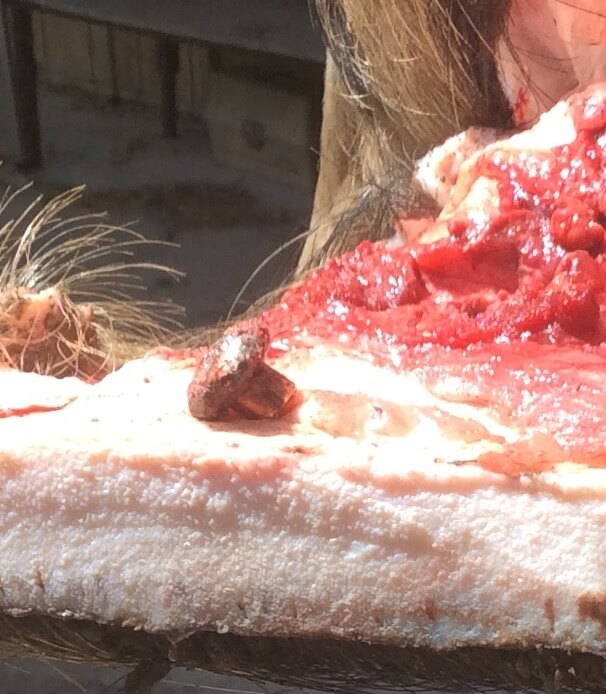
The tendency for boars to have an extra thick “shield” of skin and cartilage upwards of 1″ thick, plus denser muscle can hinder even large caliber premium bullets from obtaining complete penetration. A hunter of mine brought a 35 Whelen using 225gr. Trophy bonded BearClaw bullets, ordinarily a combination that would be considered more than capable. He shot a nice 250 pound boar at less than 50 yards. The bullets muzzle velocity was 2600fps. so it hit the pig with little velocity loss. The pig was a perfect broadside target as we would later find out but the bullet landed on the shoulder and did not exit the pig! At the shoulder, the pig was about 22-24″ thick. We discovered the bullet stopped in the offside shoulders shield.
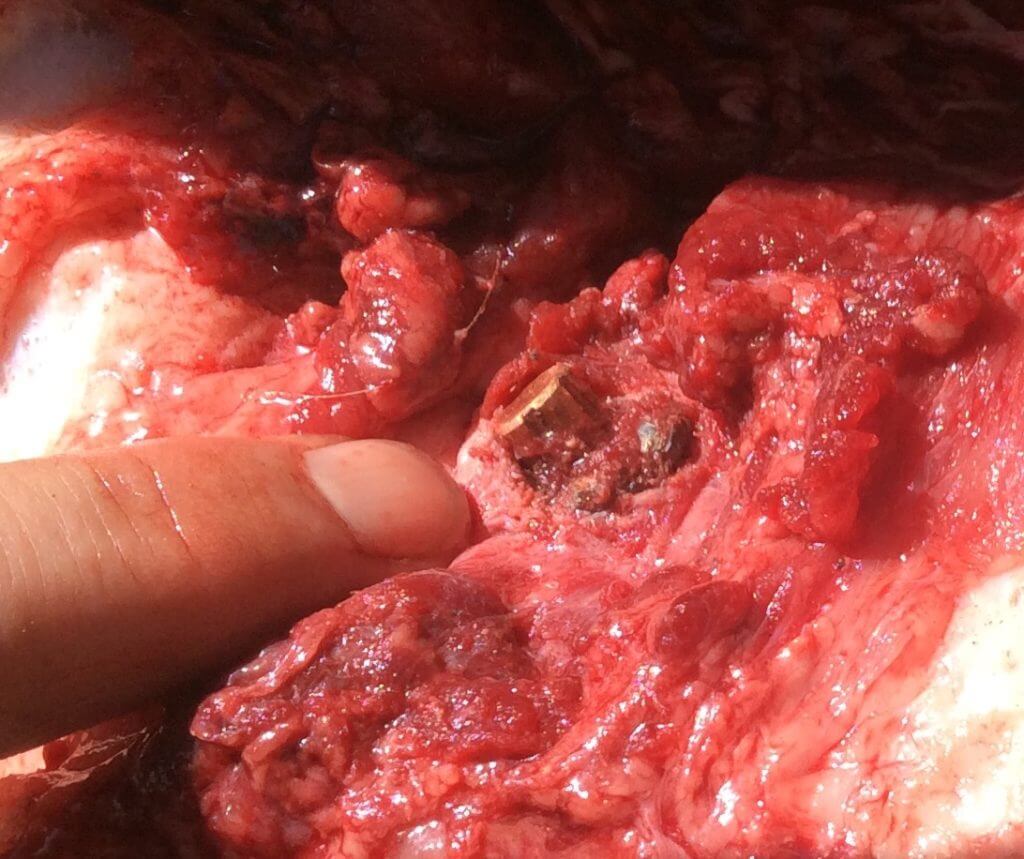
The shield on that pig was just over 1″ thick. The bullet broke both shoulders, some ribs, hit both lungs and dropped the pig with just a bit of kicking before death. The shot was taken at sunset, and luckily no tracking job was needed because there was no blood trail or blood leaking from the entrance wound. The fat from a porker does a good job of sealing up holes made by bullets entering so if a tracking job is needed your best hope is for an exit wound. The bullet performed just like the advertising; it delivered a devastating blow, but if the pig had run even 50 yards it would have made it to dense cover and possibly been lost due to no exit wound. Mushroomed bullets make for pretty pictures and the fact that you have the bullet means you got the animal but how many perfect mushrooms are never found in animals because they left no exit wound, and so the animal was never found. My opinion here is that given the high impact velocity the bullet lost some penetrative quality, if the pig had been 100 yards farther the bullet could possibly have exited due to lower speed and slower expansion.
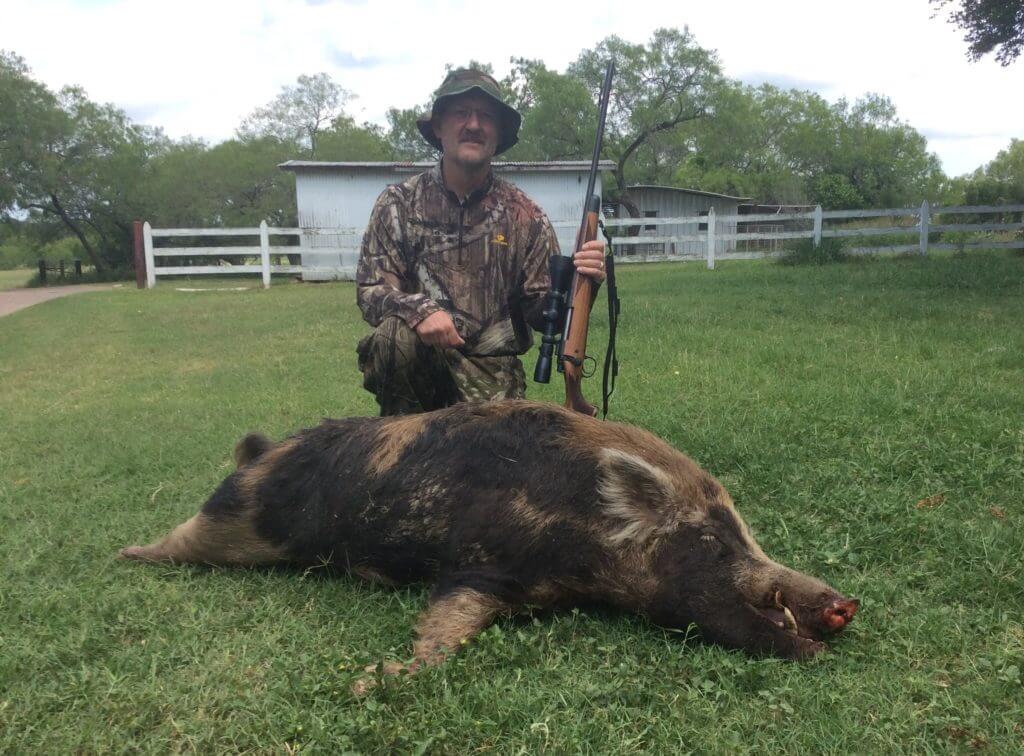
So my recommendation for taking pigs of any size, at reasonable hunting distances is simply…
A moderate to heavy for caliber bullet and moderate velocity. Remember to match the bullet to the game, and strive for two holes. Even though they’re pigs, they still deserve a humane death, besides, the less time you spend looking for a hit pig is more time spent looking for more pigs!
Hornady.com Nosler Bullets